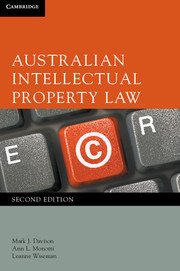Book contents
- Frontmatter
- Contents
- Preface
- Acknowledgements
- Table of statutes
- Table of cases
- 1 Introduction
- 2 Passing off
- 3 Registered trade marks
- 4 Exploitation of registered trade marks
- 5 Copyright: introduction
- 6 Subsistence of copyright
- 7 Authorship and first ownership, nature of the rights and duration
- 8 Exploitation, infringement and defences
- 9 Moral rights, performers’ rights, artist's resale rights, and other rights
- 10 Designs
- 11 Equitable doctrine of breach of confidence
- 12 Patents for inventions: introduction
- 13 Patents for inventions: validity
- 14 Patents for inventions: allocation of rights and ownership, the Register and dealings
- 15 Patents for inventions: exploitation, infringement and revocation
- 16 Plant breeder's rights
- 17 Remedies and miscellaneous issues
- Index
- References
5 - Copyright: introduction
- Frontmatter
- Contents
- Preface
- Acknowledgements
- Table of statutes
- Table of cases
- 1 Introduction
- 2 Passing off
- 3 Registered trade marks
- 4 Exploitation of registered trade marks
- 5 Copyright: introduction
- 6 Subsistence of copyright
- 7 Authorship and first ownership, nature of the rights and duration
- 8 Exploitation, infringement and defences
- 9 Moral rights, performers’ rights, artist's resale rights, and other rights
- 10 Designs
- 11 Equitable doctrine of breach of confidence
- 12 Patents for inventions: introduction
- 13 Patents for inventions: validity
- 14 Patents for inventions: allocation of rights and ownership, the Register and dealings
- 15 Patents for inventions: exploitation, infringement and revocation
- 16 Plant breeder's rights
- 17 Remedies and miscellaneous issues
- Index
- References
Summary
Introduction
Copyright law regulates the creation, dissemination and use of a range of different types of ‘works’, from books, plays, musical works, computer programs and films through to sound recordings and television broadcasts. In developing the legal framework to regulate copyright, the law has attempted to balance the interests and concerns of copyright owners with those of authors, users and the public more generally. For example, in setting the duration of copyright protection, the law has balanced the interests of copyright owners, who have always argued for longer protection, with those of the public more generally, who have an interest in the duration of protection being more limited.
Unlike the case with other intellectual property rights such as patents, trade marks and designs, copyright protection arises automatically on the creation of the copyright work. In order to qualify for protection, a work needs to fall within one of the categories of subject matter that are recognised under the Copyright Act 1968 (Cth). One of the features of Australian copyright law is that a general distinction is drawn between Part III authorial works (literary, dramatic, artistic and musical works) and Part IV entrepreneurial works or, as the Copyright Act prefers, ‘subject matter other than works’ (films, sound recordings, television and sound broadcasts, and published editions). This distinction is important because it influences the criteria that need to be satisfied for a creation to qualify for protection, the nature and duration of the rights that are granted, as well as the defences that are available.
- Type
- Chapter
- Information
- Australian Intellectual Property Law , pp. 184 - 201Publisher: Cambridge University PressPrint publication year: 2011



